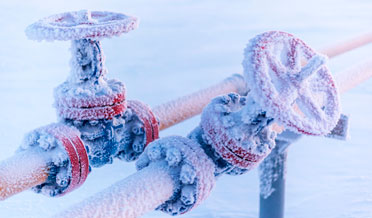Winterize Your Home’s Plumbing to Prevent Costly Plumbing Repairs
The temperatures in South Texas are usually very mild in the winter—that’s one of the things we love about this place. It is unusual for the weather to drop and stay below freezing for an extended period. However, the rarity of extremely cold temps should not lead one to forget that freezing temperatures happen occasionally, and a little preparation can avoid a lot of inconvenience and plumbing repairs.
The first step is to determine the vulnerabilities of your supply plumbing since the drains are not a major risk for freezing.
- Find the place where the water supply enters your home. Remember, the water main is buried several feet below the surface to prevent freezing, so it will enter from underground. Look for the shutoff valve at this location as well.
- Map the pipe pathways throughout the house, to each faucet and appliance. This network may pass through floors, walls, and attic spaces.
- Determine the spaces where the water pipes pass through unheated spaces—a garage, crawlspace, or attic. These pipes will need to be protected from freezing temperatures and will prevent costly plumbing repairs.
Pipes in unconditioned, unprotected spaces will need to be wrapped in heat tape, a wire that generates heat when activated. This ensures a measure of protection when outdoor air turns frigid.
Do not forget to protect outside faucets and appliances that include a water supply.
- Disconnect a hose and drain the water.
- Often, outdoor faucets allow the water to be drained between the indoor supply and the outdoors.
- Home improvement stores also supply insulated covers to protect faucets from the cold.
Do not forget a water heater stored in an unconditioned space and subject to cold temperatures; that would include an unheated garage, attic, or crawlspace.
- Home improvement stores supply insulated jackets for water heaters stored in unconditioned spaces.
- Both cold and hot water pipes will need to be taped for protection.
- Do not turn the water heater off during the winter, even if plans include extended trips away. This should add a measure of protection should the temperature drop suddenly.
It might seem cost-effective to turn the heat off during extended stays away, especially since winters are so mild. However, this is not advisable, since the weather is also unpredictable. Maintain the indoor temperature above 55 degrees. This is a sufficient temperature to keep pipes above 32 degrees and avoid frozen pipes and costly plumbing repairs, even in extreme temperatures.
If a power outage happens during a cold snap, several steps can be taken to protect the water lines.
- Open the doors of vanities, exposing the pipes inside to the existing warm air. Open doors to a water heater closet for the same reason.
- Open the valve for each faucet to allow a slight trickle of water to flow—each sink, tub, and shower. Moving water will not freeze in pipes and the opening in the valve prevents the pressure in pipes should the water freeze.
Need Help Winterizing Your Plumbing to Avoid Costly Plumbing Repairs?
Let Doctor Cool assist with all of your winterizing questions to prevent costly Plumbing Repairs. Call Doctor Cool & Professor Heat today at 281-338-8751 or email Doctor Cool and let our professional Residential Plumber Repair Contractors assist with all of your plumbing winterizing needs.

